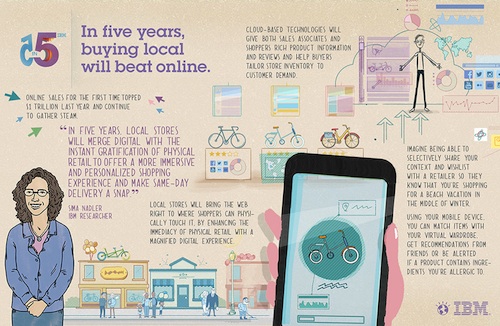IBM released its “5 in 5” report last week. It’s supposed to showcase how the world will look in five years via technology and smart computing; they also released a series of videos, which are embedded throughout this post (and deliciously narrated by Mo Rocca of CBS/NPR game shows). Dr. Bernard Meyerson, who’s the VP of Innovation for IBM, heads up the research team.
There are a ton of different observations in the ‘5 in 5’ report, most of which are detailed here and address issues of living in cities, medicine, digital guardians to prevent identity theft, what shopping will be like, what education will be like, and more. Here’s probably the best quote from Meyerson on the entire process:
“You literally change the future. It’s not science fiction. We can do that. If we can do it in something like traffic flow, believe me, we’ll eventually be doing it in medicine, and we’ll be doing it in many aspects of life.”
I think about this a lot. When Apple was developing the iPhone and Jobs and his people were probably yelling at developers/engineers to put a better camera in it, how many people at Apple — and/or who had knowledge of Apple’s plans — were telling themselves how ridiculous it was? (“Why would anyone take pictures with their phone?”) That’s just one small example. If you had told people coming back from Vietnam that within 30 years we’d have a complex series of sites that people could visit for quick shots of information/news/context, that would seem unbelievable. (“You mean professors could do that, right?”) Sometimes we think of ideas as crazy, as in “that could only happen in some type of futuristic movie,” and then we forget how far we’ve come in even 15 or so years.
For example, regarding the idea of living in cities, Meyerson says:
“In the city, transportation right now is on a fixed schedule as opposed to need. What if you actually had the ability to detect ahead of time the motion of your citizens and adjust your flow of transport capability to match the immediate need? So that maybe a baseball game went two hours long, you realize that meanwhile you may have had 14 trains tied up at local stations waiting for all the folks coming out of the stadium who never show up.”
“Contrast that with looking at everybody’s cell phones and where they are, and anonymizing the data. But taking that anonymous result, you nonetheless know that, ‘Wait a minute, all of a sudden 35,000 people got out of their seats or are heading for the exits.’ You know it’s time to spool up the transport system.”
Cities and their leaders will make decisions based on infinite different types of information that will be visualized on fluid heat maps of city systems. Using advanced analytics, it will be possible to understand and continually digest new information freely provided by citizens. Cities can become more flexible, increasingly flatter, less encumbered by bureaucracy, and more open to sharing data and insight.”
That seems crazy, right? Anonymizing data of people at a concert or large-scale event and then running transport off of that? But it could pretty easily happen.
The idea is that right now, we live in cities on their terms; in five years, cities will shift to work on our terms. I know that sounds weird because a city is an inanimate object, but the idea is there.
The idea that buying local will surpass buying online is probably a little controversial — after all, isn’t Amazon exploding beyond anyone’s wildest dreams? Isn’t it about to get drones? But the idea is that cloud-based data, mixed with cell phones, could connect retailers directly to you:
You walk into a store and based on what you’ve been searching/texting about, the store knows you need Pampers, or a broom, or whatever. The store tells you the aisle and the location and even some of the models. You just saved 20 minutes. Could you reinvest that in something worthwhile? The store just gained a sale and quick, effective customer service — so hopefully some loyalty in the process. Says Meyerson:
“It has been physical against online,” Meyerson said. “But in this case, it is combining them. What that enables you to do is that mom-and-pop stores can offer the same services as the big online retailers. The tech they have to serve you is as good as anything in online shopping. It is an interesting evolution but it is coming.”
That’s kind of weird to think about. Local stores do have an advantage — Amazon Prime is great, but it’s still 1-2 days to wait for something. What if you need it immediately? You need to shop local. Local isn’t harnessing that power because of stuff like inventory, wait times, finding help, knowledge, the need to trudge outside your house, etc. But if “local” could use smart technology to close those gaps … that’s a legitimate game-changer.
There’s thousands of articles about IBM’s predictions online, including here, here and here. You can look through those at your leisure; it’s all pretty interesting. And if you doubt the veracity of this stuff, check out their 2008 predictions and how they measure up in 2013 — because of Google Glass, Siri, 23andMe, and stuff like Vine, they’re actually pretty spot-on.


One Comment
Comments are closed.